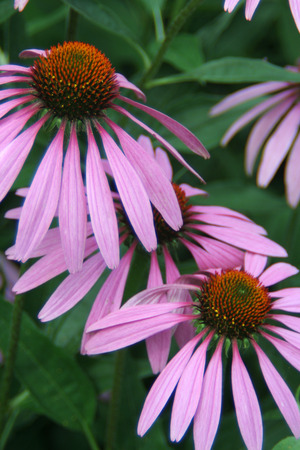Purple coneflowers are hardy in U.S. Department of Agriculture zones 3 through 10. The happy daisy-type flowers, blooms July to September. The flower colors come in a wide variety like pink, purple, yellow, cream, and orange. Depending on the variety, they grow from 24 to 38 inches tall with a spread of 18 inches. Purple coneflower has a number of common names like marmalade gloriosa daisy, black-eyed Susan, and Echinacea.
Purple coneflowers is a perennial flower that made its way to America in the mid 1800’s. The Native Americans knew the medicinal benefits of this plant. and used to care for people and horses. They used the flower along with the roots to make a tea or compress. This concoction treated a variety of problems like scarlet fever, ear problems, burns, and sores. They used it to treat people and horses. Even today, people use purple coneflowers to help ward off a cold or the flu.
Location and Soil Preparation
Plant your purple coneflowers in the spring. Find a garden spot that has full sun exposure and well-drained soil. Remove the weeds or grass in the planting area so the flowers doesn’t have to compete for moisture and nutrients.
Place 2 to 3 inches of organic compost over the soil, along with some granular fertilizer or manure. Dig or till this into the soil. Compost adds nutrients, helps with drainage problems in your soil, and lightens it. Level the soil with a rake and remove any sticks, hard clumps, or rocks that the tines bring to the surface. If possible, leave the soil to settle for three or more days.
Planting
Dig a hole that is twice as wide as the rootball, but keep the planting depth the same. Remove the purple coneflower from the container, being careful not to break the soil around the roots. Inspect the rootball and if the roots are visible around the outside, gently tease them free. If you allow the roots to continue growing around the rootball in that fashion, they will choke the plant to death. Cut away any broken or diseased roots to keep your plant healthy.
Place the roots in the hole, making sure that the top of the rootball is level with the ground. Fill in with soil, firming the garden medium with your hands to remove air pockets. Don’t compact the soil too much or the ground will turn hard. Space the purple coneflowers at least a foot apart.
Water
Water the purple coneflowers thoroughly and deeply at ground level. Resist watering them with an overhead sprayer. The best time to water is early in the morning or early in the evening. That way the leaves have a chance to dry off. Watering at night promotes disease because the leaves stay wet.
Once your purple coneflowers become established, they are drought tolerant. You don’t need to water them much unless your area is going through drought conditions.
Mulch
Place a 2-inch layer of organic mulch over the ground, around the plants. Mulch keeps the soil moist and prevents the weeds from growing. Do not pile the mulch against the purple coneflowers stems, because that keeps the area wet. This makes them more susceptible to disease. Keep the mulch 1 or 2-inches away from the stems.
Deadheading
Cut the flowers for bouquets or for drying. Deadhead the spent blossoms to encourage a second blooming period. Later in the season, leave some flowers on so they can go to seed. They will self-seed themselves back for the next season.






